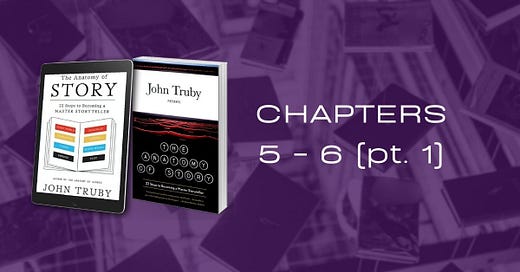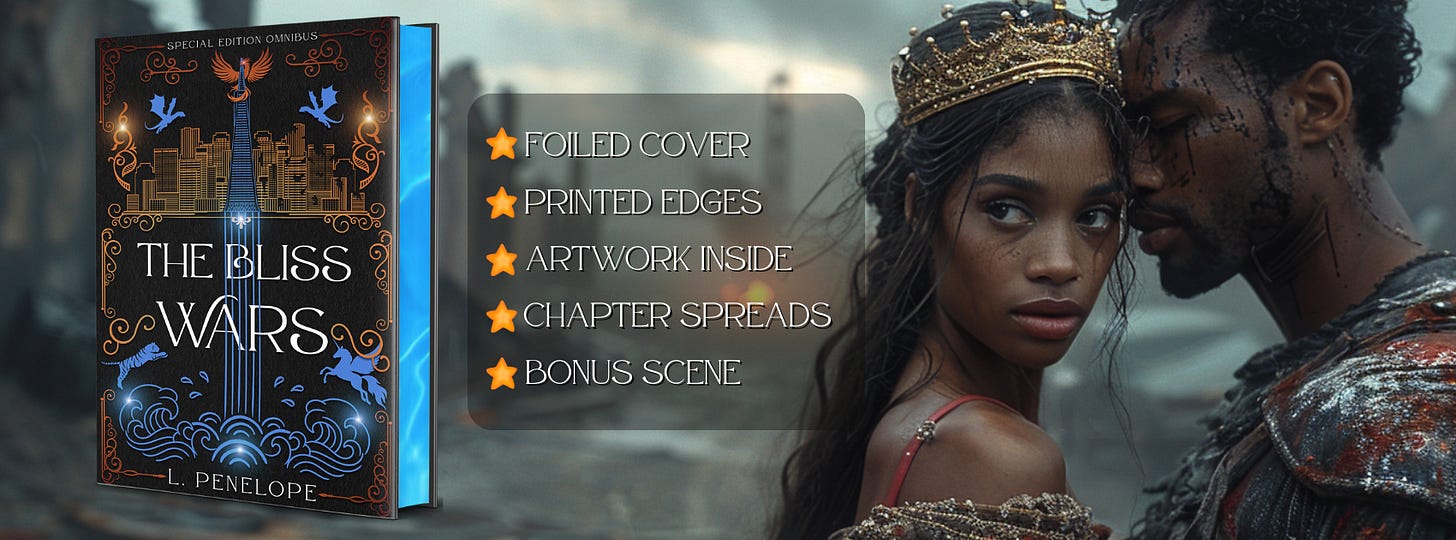What Is Your Story Really Saying?
Chapters 5 & 6 (pt. 1) of The Anatomy of Story by John Truby
Welcome back to the Marginalia Book Club where we dive into craft books for writers in order to improve our techniques.
Each post will cover specific sections of our current book, The Anatomy of Story: 22 Steps to Becoming a Master Storyteller by John Truby (Bookshop | Barnes & Noble | Amazon), with thoughts, questions, and a space for discussion.
Whether you're reading along or just curious, I hope you find something to spark your imagination and deepen your understanding of the writing craft.
Here's our upcoming schedule:
Week 4, May 13, 2025: Chapters 6 (pt. 2) - 7
Week 5, May 20, 2025: Chapter 8
Week 6, May 27, 2025: Chapter 9
Week 7, June 3, 2025: Chapters 10 - 11
Live Book Club Discussion: June 7, 2025 - 12pm ET
This week we’re going over chapter 5 and the first half of chapter 6, which deal with the Moral Argument and the Story World.
These chapters feel foundational to his method of breaking down stories, even if Truby’s tone is far too prescriptive for my tastes. That said, there are some valuable insights here—particularly for writers like me who want their stories to have deeper meaning and messages, whether we realize what that is upfront or discover it along the way.
The Moral Argument
“A great story is not simply a sequence of events or surprises designed to entertain an audience. It is a sequence of actions, with moral implications and effects, designed to express a larger theme.”
This hits home for me. I’m definitely a writer who wants to say something meaningful. However, I don’t always know exactly what that is until the story is well underway—or even finished.
I usually discover my theme sometime after the first draft is complete. So Truby’s approach—designing the story around a moral premise from the start—is not necessarily intuitive for me. And if you're a more exploratory writer, a pantser or gardener, then this will be detrimental to your process.
(It’s definitely worth reiterating again—and probably many times throughout this book—that there is no one way. If you're reading writing advice that does not resonate with you, feel free not to do it.)
For Truby, the theme isn’t a one-word concept like “love” or “freedom.” Instead, it’s a moral argument: a nuanced point of view on how to live. He calls this your “moral vision,” and it’s expressed through character decisions and story structure, not just through dialogue or narration.
In fact, a story becomes preachy when the moral argument outweighs the plot. I recently read a book like this. It had a lot to say about the world that we live in. However, the plot was both simple and confusing at the same time. I was often bored and the character conversations definitely edged towards the preachy because the author had so much to say. But the dialogue and conversations were often not in service to the larger external plot.
Anyway, moral arguments are presented as part of various types:
Good vs. Bad – called “the lowest variation” because it’s simplistic.
Tragedy – The hero has a fatal flaw and realizes it too late. It’s about consequences.
Pathos – The doomed hero doesn’t grow, but their struggle has emotional resonance. Think beauty in futility.
Satire & Irony – The character follows their society’s so-called moral rules and ends up causing harm. The system is the problem.
Black Comedy – Similar to satire, but more about absurdity and survival. The hero is likable but stuck in a broken world.
Mixing these can create depth, especially when your protagonist and antagonist want the same thing but hold conflicting values.
One point I really liked: using other characters as variations on the theme. Their different approaches to the central moral issue naturally highlight the hero’s growth or failure. And the best way to show that growth? Contrast a moral decision they make at the end with one they made (or avoided) at the beginning.
Here are some questions we can ask during plotting or revision:
What is your story’s moral argument?
What choice does your protagonist make at the end that they couldn’t have made at the beginning?
How do your other characters reflect different approaches to the central moral problem?
Where do their values conflict?
If you’re not sure of your theme while writing your first (or fifth) draft that’s okay. It’s in there, we can’t help but infuse our work with our belief system about the world subconsciously if not consciously. Sometimes and editor or readers will need to tell you what you were really writing about.
The Story World
Chapter 6—which is so long that we’re dealing with it over two weeks—focuses on creating a world that supports and enhances your story’s theme and character arcs.
“...creating a unique world for the story—and organically connecting it to the characters—is as essential to great storytelling as character, plot, theme, and dialogue.”
This echoes what I teach in my worldbuilding course: that plot, character, and setting are inextricably connected, each feeding one another to create the whole. Truby’s concept of the story world as a “web” where everything is interconnected fits well with this approach.
That said, I do wish he were a bit more flexible in tone. He tends to suggest that there’s one right order for doing things—design your story world after your designing principle but before you get too deep into structure, etc. I don’t think every writer’s process can or should work this way. For me, world and story almost always grow up together.
He also talks about visual oppositions in worldbuilding—using contrasting environments to reinforce thematic elements. Like the vibrant vs. dystopian versions of the town in It’s a Wonderful Life, or Skull Island vs. Manhattan in King Kong. I’m not totally sold on the idea that every story needs this kind of opposition, but it’s definitely a tool worth keeping in your kit.
So far, the breakdown of story world details includes:
Natural Settings – Symbolic use of landscapes, weather, seasons. (Pro tip: OneStopForWriters.com has amazing resources for this.)
Weather – Classic metaphors like rain = sadness still work, but the key is to use them in fresh ways.
Man-Made Spaces – Homes, roads, schools, even weddings. These “worlds” reflect characters’ inner lives and societal roles.
The world of your story doesn’t have to be a planet. It can be as small as a single house. It can be a wedding. Or a car. I’m looking forward to seeing what the rest of the world chapter holds.
Final Thoughts
While this book’s approach can feel overly methodical at times—especially for intuitive or discovery writers—I appreciate his focus on why we tell stories. He reminds us that it’s not just about plot twists or cool magic systems. It’s about saying something real. Offering a point of view. Posing questions. Exploring contradictions.
So whether you outline every beat or discover your story in the writing, it’s worth revisiting these ideas when you revise. Ask yourself:
What is my story saying?
How does the world reflect that?
How do the characters embody (or resist) it?
As always, take what’s useful, leave what isn’t, and trust that your voice—your unique vision—is the real magic at the heart of your stories.
📢 What do you think about Truby’s take on moral arguments or story world design? Do you consciously build theme into your stories, or let it emerge later?
I’d love to hear your process! Let us know in the comments!
Imaginary Best Friends, head here to download the bonus worksheet for this section!
I’m celebrating my 10 year publishing anniversary with a limited special hardcover edition of my enemies-to-lovers, portal fantasy romance series, The Bliss Wars.
If you love stories filled with warring shifter clans, forbidden love, and heart-pounding adventure, this series is a must-read. And this edition? It’s a true collector’s dream: a brand-new foiled cover (so pretty 😍), custom printed edges, beautiful chapter designs, interior character artwork, and even a bonus scene!
The preorder campaign is all-or-nothing (the books won’t get printed unless we meet the gaol) and we’re almost there! When you reserve your copy, you won’t be charged until the campaign is fully funded — and books will ship in early June.
✨ Don’t miss your chance to own this gorgeous special edition! ✨
More about the trilogy:
In a shattered world of rival shifter clans, ancient prophecies, and dangerous secrets, three forbidden love stories unfold.
Talia, a lost soul mistaken for royalty, must navigate lies and a deadly war to uncover her place in a city divided. Xipporah, a warrior consumed by vengeance, risks everything by marrying her enemy to save her people. And a princess fighting to become a queen discovers her greatest strength while trapped in an abandoned fortress—and in the arms of a terrifying beast.
As alliances crumble, enemies turn to lovers, and sacrifices mount, The Bliss Wars trilogy weaves a gripping tale of love, loyalty, and survival in a world on the brink of annihilation.





